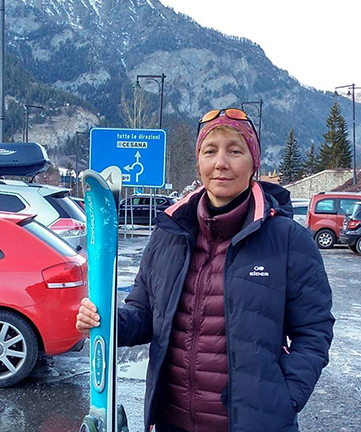
Tatiana Novikova
In this installment of Senior Member Insights, we talk with Tatiana Novikova. Tatiana is a research scientist and head of the Applied Optics and Polarimetry group in the Laboratory of Physics of Interfaces and Thin Films, CNRS, École Polytechnique, France. Prior to joining École Polytechnique, Tatiana was a research scientist at the Institute for Mathematical Modeling, Russian Academy of Sciences, Russia. Her current research interests focus on the applications of polarized light for metrology in microelectronics and for biomedical diagnostics.
What first interested you in pursuing science?
It’s the freedom to choose and to work on what you really like. You take your scientific journey as an adventure, you solve the problems, push the limits of your knowledge, and, sometimes, you can be proud of yourself.
Have you encountered a period where you have been discouraged in your pursuit of science? If so, how did you persevere?
I had several years of maternity leave. It was not exactly a discouragement, but rather a conscious decision to take a break, because my son needed me. During that time, I realized how much I like my job as a scientist and I decided to come back.
Of the conferences you’ve attended, has there been a stand-out topic, session or interaction that really stuck with you or changed your perspective?
In general, attending conferences keeps your mind open and gives a unique opportunity to monitor the pulse of today’s research, learn about new challenges outside your immediate field and communicate with the researchers all over the world.
Just recently, I was particularly impressed by the presentation of slide-free tissue microscopy with ultraviolet surface excitation, during the “Hot topics” Session at SPIE Photonics West BIOS 2017. This technique was jointly developed by medical doctors and researchers from the semiconductor industry, using a UV metrology approach for biological tissue characterization.
It is an exemplary illustration of the importance of an interdisciplinary approach, which helps to find new, revolutionary solutions to the problem. It caught my attention because in our group we also work on the applications of polarized light for metrology in microelectronics and for biomedical diagnostics.
What is one piece of advice that you wish you were given as a student/early in your career?
Once, my Ph.D. advisor told me that there are two “La Vie en Rose” periods in the life of a researcher. One is in kindergarten, and another one is time in graduate school. Now, I would agree with the first part of this statement only. When you decide to go for the Ph.D. degree, be ready to work hard in pursuing your objectives. Time runs short, and this resource is not a renewable one.
What have you learned by being a mentor to others, and what have you learned from mentors who helped shepherd your career?
It’s important to realize that “mentor–student” relations are always like a two-way street. Both sides should be active. The more you give, the more you get back. It works both ways. I had many good teachers and hope that my students can say the same about me.
What are habits each day that help you to be successful?
Being a group leader, I have to combine both scientific and administrative work. Science is about an inspiration; at least, this is an important part of the scientific work. Management of research does not leave room for much improvisation. I use an electronic assistant to schedule my meetings, duties, deadlines, etc., and make plans well in advance.
How important are leadership roles in career development and how do you hone your leadership skills?
It’s a very useful exercise to take a look at the problem from the other side of a barrier. When you are a team member, you share the responsibility for yourself only. Being a leader means that you should step up and accept the responsibility for your team and your projects, but also for the interactions between team members. I am still learning every day how to do this properly.
What advice do you have for young scientists who are about to interview for their first job?
I would advise young scientists to be honest at the interview. Do not pretend to have knowledge or skills that you don’t have. Show your strong motivation for the job you are applying for. Explain what your value is for the employer and do not hesitate to ask questions. An interview—it’s a dialogue, not a monologue.
At this point in your career, what are you most looking forward to next?
I would like to start a new line of research in our laboratory – studies of the interaction of light carrying optical angular momentum (OAM) with biological tissues for biomedical applications. The preliminary results hold great promise for an increased accuracy of tissue optical diagnostics with OAM beams.
If you weren’t in the sciences, what would be your dream career?
I would not mind becoming a professional tennis player. Playing tennis is like playing chess; both require the highest concentration, combinational thinking and an ability to select the best possible solution in a limited time. Actually, all of these we need in science as well!
